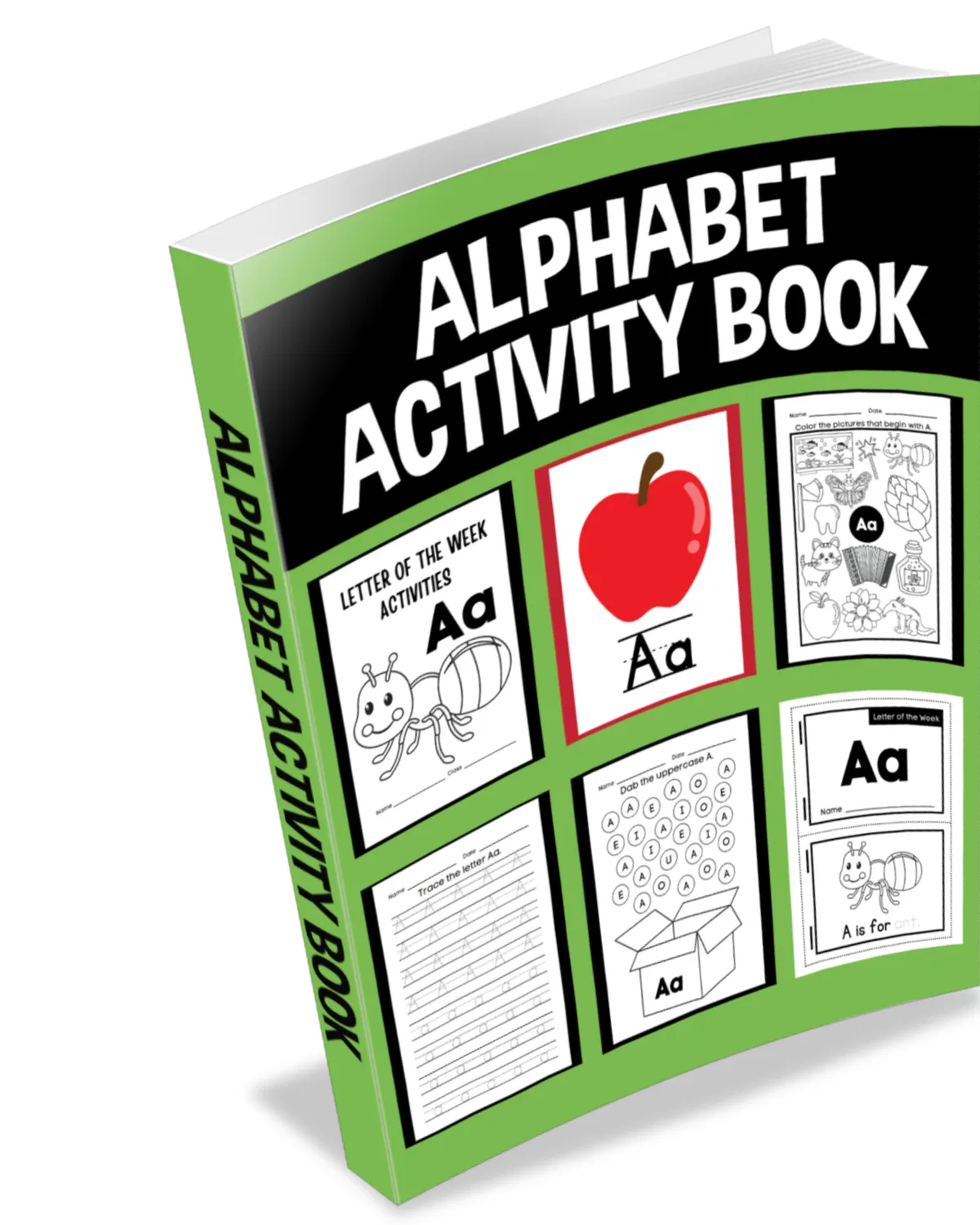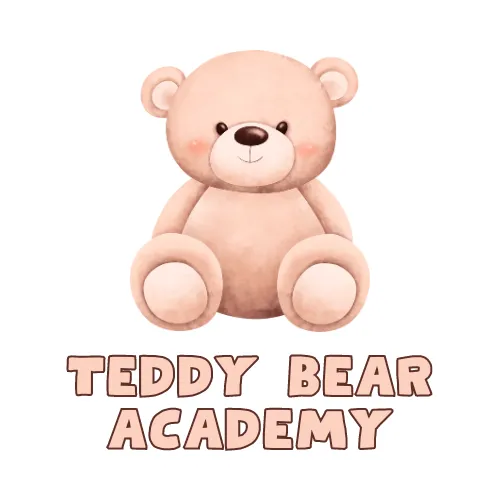Want a FREE Alphabet Activity Book? FIND IT HERE!
LITERACY
Letter Names or Letter Sounds
03 May 2024

The more you read, the more things you will know. The more that you learn, the more places you'll go”
- Dr. Seuss

Are you looking for help teaching your preschooler?
Why not join our Teddy Bear Academy for fun and engaging activities designed by a Primary Teacher?
Have you noticed how we sing the "A, B, C.." song the A is not the same sound as when we say "apple"?That is because in English each letter has a name and at least one sound. That is why learning to read is such a complex skill. Here, I will briefly explain the theory and what we can do with it to help our preschoolers learn their letters.
What do I need to know?
1. There are 26 letters in the English alphabet.
2. There are 44 sounds (also called phonemes) in the English language.
3. Some letters have one sound (b, d, m), others have more (a as in apple or acorn, c as in car or cent, g as in guitar or giraffe).
4. Some letters join together to create a new sound (ow, th, ch, ea)
Does my preschooler need to know all this?
Absolutely not! Their literacy learning is about recognising sounds, rhymes, singing, oral blending, expanding their vocabulary, etc. Learning to recognise letters of the alphabet is actually quite a complex skill that requires other skills to be mastered first. In our signature programme, we go through all the skills step-by-step, build on the previous knowledge and help your preschooler learn the letters the right way, backed by research and modern school practice.
What does my preschooler need to know about the letters then?
Each letter of the alphabet has 3 main components:
1. Letter Name
2. Letter Sound (one or more)
3. Letter Formation (what it looks like)
Is it better to teach letter sounds first?
There is some debate in the educational space about teaching only letter sounds along letter formation and only introducing letter names when children have mastered the basics of reading and writing. There is other research that suggests that children are very capable of learning all three components at the same time.
When children start their education at school in Britain, the preferred method is to only teach letter sounds when introducing letter shapes (formation), with letter names being introduced at a later stage. The reality is that when parents sing nursery rhymes at home with their preschoolers, they also sing the traditional "A, B, C" song that mentions letter names. What is more, many preschool establishments do that, too.
In the USA, the preferred method is to embrace the previous knowledge that the children come to school with and focus on all three components at the same time. National data for the USA, England and Scotland shows similar results across age groups, which proves that whichever method you choose, children are very clever and competent and will learn to read either way.
Would too many components to learning their letters not confuse them and make the process more difficult?
Yes, they will get confused at some point but that is a normal part of the learning process. Our job as parents and teachers is to help them systemise their knowledge, make it familiar and provide opportunities for them to test their newly mastered skills in new, unfamiliar situations.
What is the most important part of the process at the 3-4-year-old stage, though, is that we read to and with our preschoolers regularly and expose them to rhymes, songs and various phonics and sounds games.
What can I do as a parent to help my preschooler improve their literacy skills?
You can do a lot, actually! But I would recommend you start with these:
- Read, read and read. Every day for at least a few minutes.
- Sing nursery rhymes every day.
- Play sound games whenever you have a minute or two.
- Play letter recognition games and letter formation games.
- Set up games for fine motor skills development (that help the muscles in their hands and fingers).
If you would like more guidance on these, I would recommend signing up to our free newsletter. When you join our community, you will receive emails with tips, detailed game suggestions and freebies. My mission is to make it all simple and fun for you and your preschooler. When they are playing, they do not realise they are learning.

Here is your FREE Alphabet Activity Book to get you started.
Additional activity ideas and educational tips will be delivered straight to your inbox.
Bibliography:
Barlow‐Brown, F. & Connelly, V. (2002). The role of letter knowledge and phonological awareness in young Braille readers. Journal of Research in Reading, 25, 259 – 270.
Barron, R.W. (1994). The sound‐to‐spelling connection : Orthographic activation in auditory word recognition and its implications for the acquisition of phonological awareness and literacy skills. In V.W. Berninger (Ed.), The varieties of orthographic knowledge 1: Theoretical and developmental issues. (pp. 219 – 242). Dordrecht, The Netherlands: Kluwer Academic Press.
Beech, John R. (2005) Ehri's model of phases of learning to read: a brief critique. Journal of Research in Reading; Feb2005, Vol. 28 Issue 1, p50-58
Blaiklock, Ken E. (2004) The importance of letter knowledge in the relationship between phonological awareness and reading. Journal of Research in Reading; Feb2004, Vol. 27 Issue 1, p36-57
Block, Meghan K.; Duke, Nell K. (2015). Letter Names Can Cause Confusion and Other Things to Know About Letter-Sound Relationships. YC: Young Children , Mar2015, Vol. 70 Issue 1, p84-91
Bowman, Margo; Treiman, Rebecca.(2004) Stepping Stones to Reading Theory Into Practice, Autumn2004, Vol. 43 Issue 4, p295-303
Burgess, S.R. & Lonigan, C.J. (1998). Bidirectional relations of phonological sensitivity and prereading abilities : Evidence from a preschool sample. Journal of Experimental Child Psychology, 70, 117 – 141
Caravolas, M., Hulme, C. & Snowling, M.J. (2001). The foundations of spelling ability : Evidence from a 3‐year longitudinal study. Journal of Memory and Language, 45, 751 – 774.
De Jong, P.F. & Van Der Leij, A. (1999). Specific contributions of phonological abilities to early reading acquisition : Results from a Dutch latent variable longitudinal study. Journal of Educational Psychology, 91, 450 – 476.
DeStefano, Heidi Heath. (2019) Voices of Practitioners: Teacher Research in Early Childhood Education , Fall 2019, Vol. 14, p71-77.
Ehri, L.C. (1983). A critique of five studies related to letter‐name knowledge and learning to read. In L. Gentile, M. Kamil & J. Blanchard (Eds.), Reading research: Advances in theory and practice. (pp. 143 – 153).
Columbus, OH: Merrill.Evans, Mary Ann; Bell, Michele; Shaw, Deborah. (2006) Letter names, letter sounds and phonological awareness: an examination of kindergarten children across letters and of letters across children. Reading & Writing , December 2006, Vol. 19 Issue 9, p959-989
Grünke, Matthias; Gürcay, Isabel; Bracht, Janine; Jochims, Alina; Schulden, Matthias; Barwasser, Anne; Duchaine, Ellen.(2024) Enhancing Grapheme-Phoneme Correspondence Learning: A Single-Case Study Using Picture Mnemonics. International Electronic Journal of Elementary Education , Mar2024, Vol. 16 Issue 3, p417-425
Johnston, R.S., Anderson, M. & Holligan, C. (1996). Knowledge of the alphabet and explicit awareness of phonemes in pre‐readers : The nature of the relationship. Reading and Writing: An Interdisciplinary Journal, 8, 217 – 234.
Roberts, Theresa A.; Vadasy, Patricia F.; Sanders, Elizabeth A. (2020). Preschool Instruction in Letter Names and Sounds: Does Contextualized or Decontextualized Instruction Matter? Reading Research Quarterly , Oct2020, Vol. 55 Issue 4, p573-600
Tortorelli, Laura. (2015) What's in a Letter Name?: Letter Names and Letter Sounds in Early Literacy. Reading in Virginia , 2015/2016, Vol. 38, p7-12
Treiman, R., Tincoff, R., Rodriguez, K., Monzaki, A. & Francis, D.J. (1998). The foundations of literacy : Learning the sounds of letters. Child Development, 69 (6), 1524 – 1540.
Wagner, R.K., Torgesen, J.K. & Rashotte, C.A. (1994). Development of reading‐related phonological processing abilities : New evidence of bidirectional causality from a latent variable longitudinal study. Developmental Psychology, 30, 73 – 87.
Wagner, R.K., Torgesen, J.K., Rashotte, C.A., Hecht, S.A., Barker, T.A., Burgess, S.R. et al (1997). Changing relations between phonological processing abilities and word‐level reading as children develop from beginning to skilled readers : A 5‐year longitudinal study. Developmental Psychology, 33, 468 – 479.
#letter names
#letter sounds
#letter formation
Leave a Reply
Your email address will not be published. Required fields are marked *
